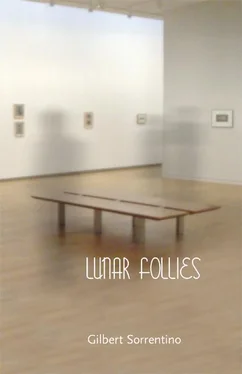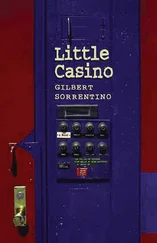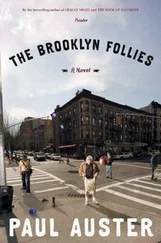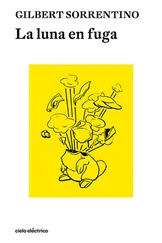Corporal Wing is chopping celery in the company mess and in the meantime Chinese mortars are laying down elegant patterns of death with lazy, terrible precision, the gooks, as they are called on this wall placard (hereon “Gooks”), can put a fucking round right up your ass if you’re unfortunate enough to bend over. It’s an inspiring collage, now you see him, now you see him as little chunks of seared flesh and splintered bone whizzing through the air. In full color. One magazine, ball ammunition, lock and load. And setting off the stirring photos of soldiers going about their everyday business is a wonderfully honest shot of Second Lieutenant Arthur M. Codgille crisply saluting the First Sergeant, Robert Swanson, with his left hand, it’s adorable, the picture nicely set off with a border of OCS patches. A comic-strip balloon, in, as someone once mysteriously said, “lonely majesty,” contains a message, to wit: THEY TOLD US WE WAS EE-FECTING A STRATEGIC WITHDRAWL, BUT ACKSHULLY WE WAS FLEEING IN WILD DISORDER. And here’s an authentic mess hall sign: Salusbury steak au juice, mash potatos, string beans, apple sause, mix salad, bread and butter, milk, coffee, ice cream. Ready on the right. Take all you want, you pussies. Ready on the left. Eat all you take, you cunts. And here is what seems to be a deposition by one Corporal John Roy Whitfield, Infantry, an astigmatic and slow-witted machine-gunner. Ready on the firing line. Corporal Whitfield’s complaint stipulates that various (and numerous) members of his platoon pissed on him throughout a long night during which he slept drunkenly in the urinal trough of the second platoon’s barracks latrine. The flag is up. No fucking way. The flag is waving. To treat a fucking noncommissioned officer. The flag is down. In the fucking United States Army. Commence firing. And a swell line drawing, delicate as all get out, left as a farewell note by a man whom the hogs ate soon after he went to shit, a diagram, actually, of how to string empty beer cans, each containing a few pebbles, on concertina wire. The whimsical caption reads: “When the clinkety-clink of the pebbles against the interiors of the cans is heard by the alert gunners, they can fire with the reasonable assurance that they are going to blow apart any fucking gook unlucky enough to be part of an initial assault, oh yes.” Stand at ease, soldier! How long have you been in the Army? The walls are brilliantly yet soberly painted in shades of khaki and olive drab.
[EXHIBITION CONTINUES ON SECOND FLOOR]
And here at last is Sir Banjo Hyde-Morrissey’s private collection of erotica. The titles of the drawings, prints, mezzotints, gouaches, woodcuts, and watercolors on display follow: Bagpipes in the Boudoir; Eating La Musette; The Burgemote Horns and Their Doxies; Presentation of the Giant Champion Bugle to the Young Queen; Blowing the Massive Horns of Westminster; Shock Tactics and French Ticklers; The Depraved Trumpeter at St. Anne’s Nunnery; Lifelong Companions, or, Asshole Chums; Queers at Table, with Gewgaws; Warriors Blushingly Confess; Albanian Musician Discovering Yorkshire Pussy; Young Ladies, in Deshabille, Fleeing Albanian Janitors; Serbs Humping Albanian Janitors, or Anybody; African Women Doing Dirty Things with Their Colonialist Oppressors; Burmese Musicians and a Popular Sponge; Apollo, with Harp and Hard-On; David Playing the Harp with Hard-On; Bellhop, with Hard-On and Pears; Woman Gazing at Hard-On in Window; Corinthian Kate in Cellophane Underwear; Harp and Details of Harp, with Hard-On and Apples in Shadow; Jeune Demoiselle Touchant “La Harpe”; Lady Playing Harpsichord, with Self-Abusing Boy in Doorway, and Daffodils; Politician with Organ-Grinder’s Monkey, with Banana, in Naples; An Increasing Nuisance Concerning a Lady’s Privates; A Band of Savoyards at Orgy, with Stuffed Kestrel; College Professors Liven Up Another Meeting, with Scattered Papers; University Don with Old Lecture Notes and Hard-On; Grotesque Scenes of Deviltry with Monkeys, on Windy Moor; Norwegian Lutherans Disrobe After Barn-Raising, with Lutefisk and Lingonberries; The Celebrated American Pianist, Bellowman, Mounting His Steinway, with Peaches and Onions; Mother and Dad Beneath the Chifferobe; Violin Hump; Lady Mary Campbell Tries a “Rubbing” with Dr. Joseph Hollman, the Old Viennese Prongmaster; Dr. Joseph Hollman Fiddles While Lady Campbell Pollutes Herself; Dr. Hollman Dons Lady Campbell’s Intimate Garments, with Zucchini; The Garden Fairy Orchestra of Canterbury Tuning Their Dildoes; Dildoes in Action, with Quince and Rutabaga; Lady Mary Campbell Brings Joy to the Garden Fairy Orchestra; Hungarians Frigging Dr. Joseph Hollman, in Legumes and Forage Crops; Hungarians Frigging Lady Mary Campbell; Hungarians Mounting Borrowed Lutefisk; African Women, with Pears and Hungarians; Albanian Janitor with Head Under Corinthian Kate’s Skirts; The Boys of St. Bart’s and Lady Mary Campbell Playing “Lost in the Gorse”; Old Waitresses in Love with Grotesque Monkeys; Waitress with Ass in Skillet; The Chef Examines His All-Girl Staff; Lady Diner Admiring Sommelier’s Tight Trousers; Diner with Hard-On Sampling Ferret Paté; Young Woman Smiling at Filthy Thought; College Professors Touching Thighs on Dais, with Name Tags and Bow Ties; Woman in Kitchen Watching Monkey Humping Casserole; Leather Madness Bewitches Waitress; Romberg’s Symphony Orchestra in Carnal Frenzy, with Toys and Language Poetry Manifesto; Lady Mary Campbell and Her Vibrating Oboe; SS Einsatzgruppenführer Discovering Louisville Slugger in Rectum; Quartet Party in Nude Frolic on Lawn, with Dried Leaves and Canned Peas; Henry Norman Surprised Anew in the Boys’ Room; The Famous Vienna Lady Orchestra Let Themselves Go; A Morning Ride, or, Unnatural Congress Between Lady Julia Pemberton and Her Stallion, “Lucifer”; Jenny Lind and Max, the Polish Tenor, with Charlotte Russe, Gourd, and Corsets; Miss Lind in the Puttit Inn Motel, with Ham on Rye; Madame Nellie Melba and Father Dirk Scucciamenza Between the Pews; North Dakotan Monkeys and Lotte Peschjka-Leutner with Her Sister, Candi Brittnee, in Bondage Frolic; A Musical Doctor Alone with a Prized Student’s Skirt; The Village Choir at It Again, with Lawn Jockey; Wandering Minstrels with Lutes and Exposed Privates; Mabel A. Royds Corrupting Altar Boys, with Missals; The Delaware Minstrels Discover the Joy and Warmth, Courage and Heartbreak of Gay Life; and, perhaps the most remarkable item, a rare and perfect dry-platinum-and-alum-process linoleum blocking of Cleveland and Billy Hill in their Great Double Song, Dance, and Buggery Act, with Banjos and Trombones, Cricket Bats, and Hand-Colored Daguerrotypes of Lady Edith Tyne-Fforke and Lady Martha Barley-Headde, Aspiring Pilots Both, Legs Akimbo, Sweating and Moaning Beneath a Perfect Replica of the Tattered Union Jack Flown by Lord Nelson at Trafalgar and the Second Battle of the Nile.
A legerdemain icon, carefully handcrafted in the ancient and sadly anachronistic “tile mills” of Tynemouth-Bourne-Stetson on Palseyshire, broods, as it were, monochromatically, above the grime-streaked window that looks out on the rain-darkened street below. The difficult configurations of the disconcerting “construction” remind some visitors, paradoxically, of the hand-colored wood engraving of the assassination of Abraham (“Abe”) B. Lincoln at Ford’s Famous Theater and Emporium (such a realization is invariably chilling, and has made more than one person quite literally sick); still, the “moral intrusiveness,” as Michelle Caccatanto has trenchantly put it in one of her dazzling occasional essays on popular culture — which is, as she has noted, “so much more than popular culture”—of “La Folie au Monde,” the title by which the work is commonly known, has convinced an equal number of viewers to see in it a classic Dutch street fair with traveling stage and performers — the latter joyously akimbo in the whirl of a traditional Dutch Sunday in Neper. Such, then, is the power of the ancient Tynemouth craftsmen and the products of their time-tested thunking, gathering, carding, wooling, ratcheting, and blooring, made, as they have always been made, in the mist-shrouded valleys of the lower-central-midlands of the verdant Cotswolds and their crystalline lakes, aromatic fens, and glowing heaps of tossed midden, not to mention the acres of dead-grey gorse that say “home!” “La Folie,” as it is familiarly known to its many devotees, can be, as Ms. Caccatanto has noted, “many things to many persons,” yet it always gently insists on its “grave, brooding humanity” and its “true message” of steadfastness and “courage.” A few commentators have suggested that Ms. Caccatanto’s deeply respectful essay quietly suggests her hidden sense of herself, in the presence of so immortal an icon as “La Folie,” as a deluded purveyor of empty blather, the very picture of the impotent and self-deluded cultural critic; but they, as one of her defenders smilingly remarks, “don’t make half her salary.” The sunlight, by the by, brings the obscurest recesses of the object to sudden, startling life.
Читать дальше












